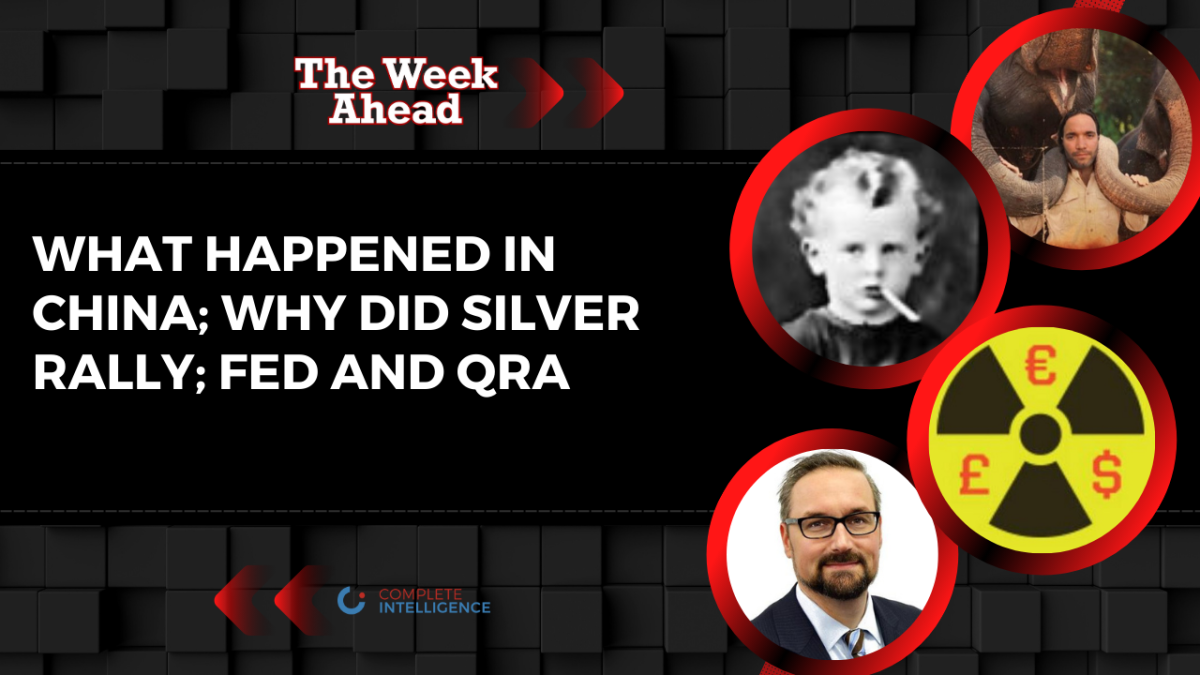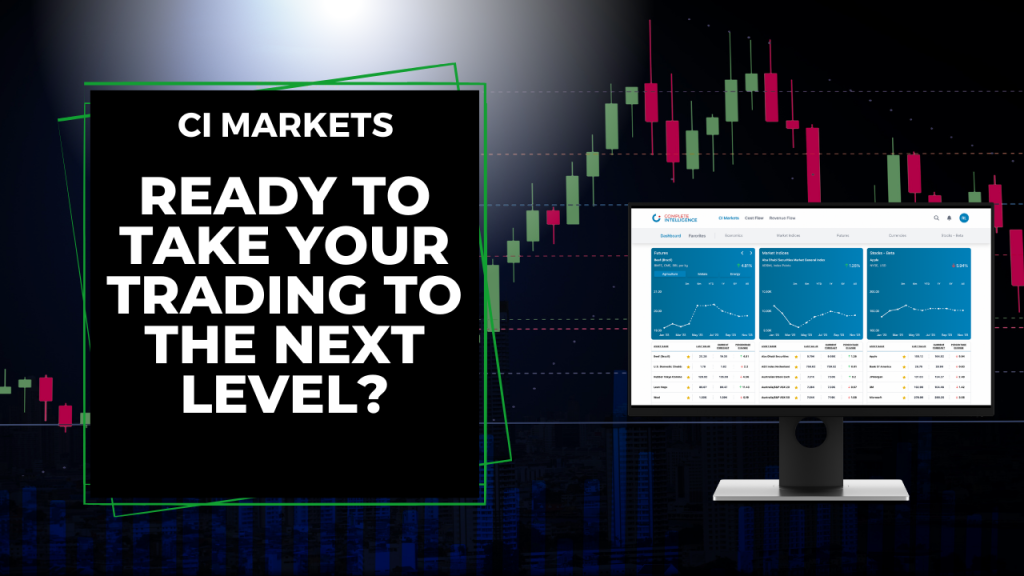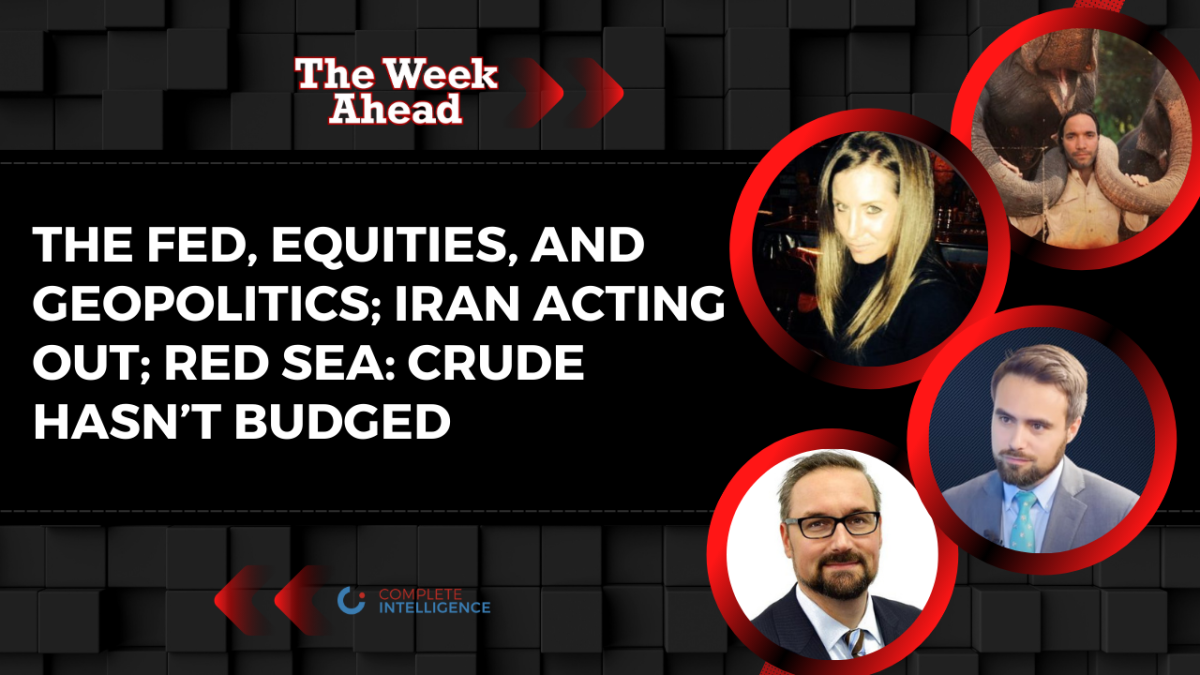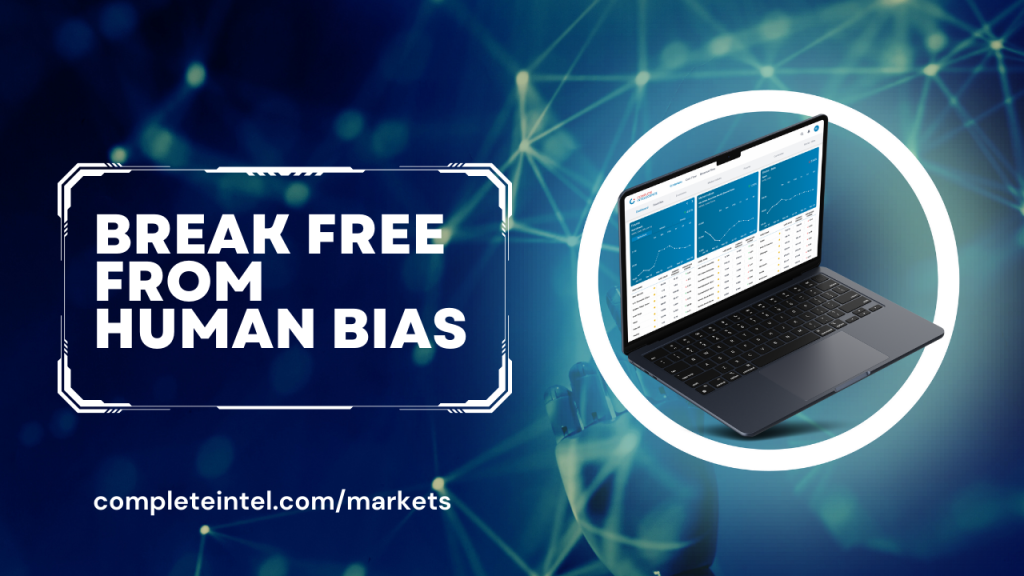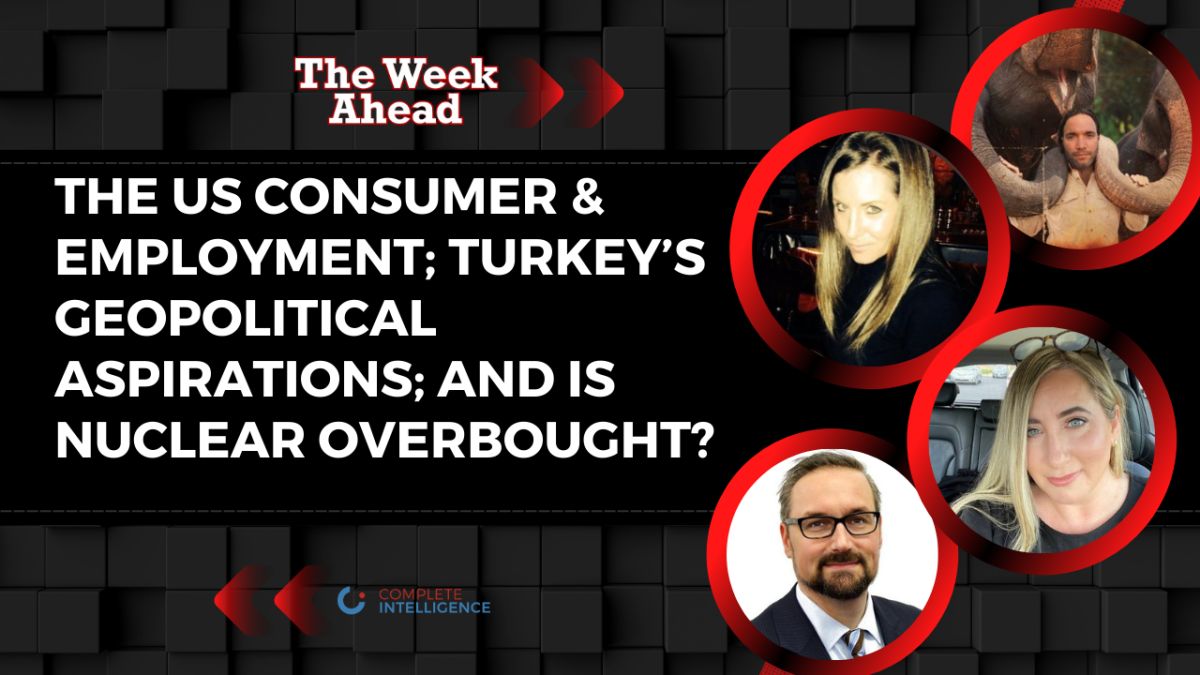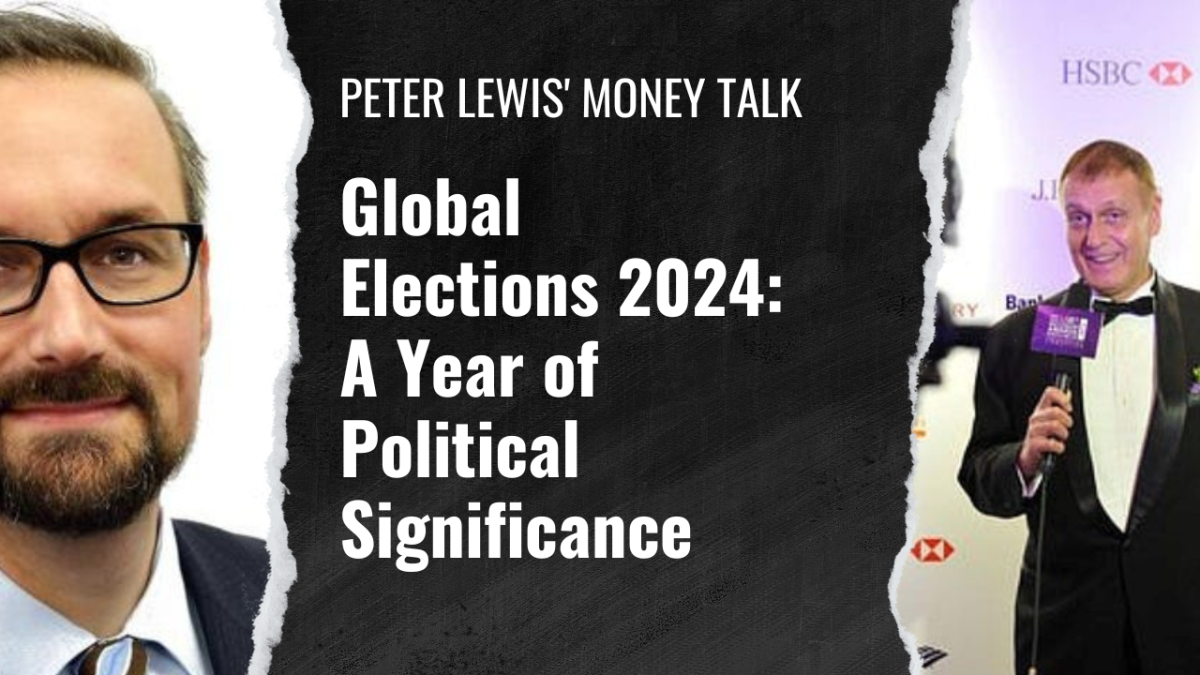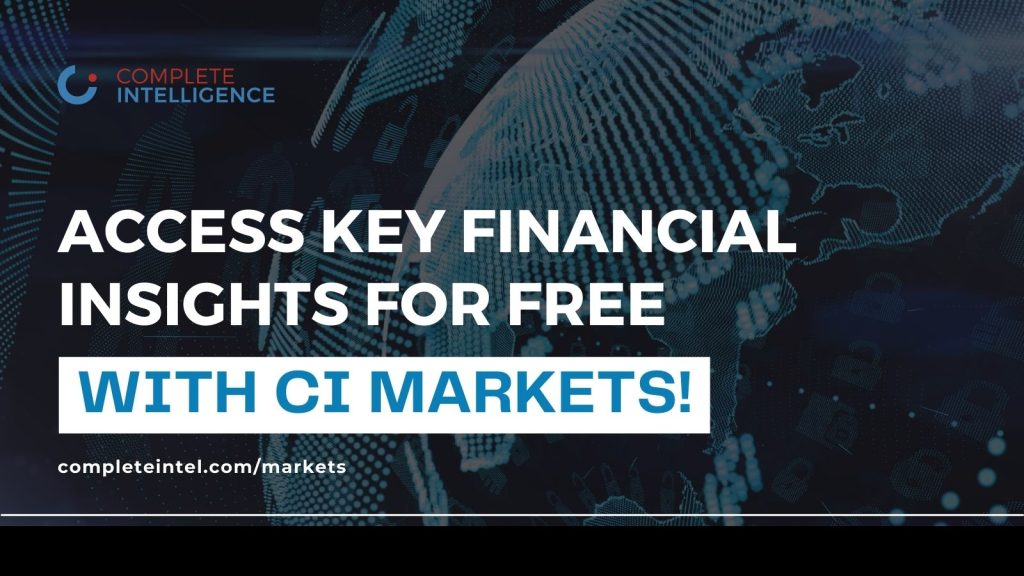#China #Geopolitics #Silver
Access AI-powered markets forecasts for free with CI Markets Free. Sign up here: https://completeintel.com/markets
Welcome to the latest episode of “The Week Ahead” with your host, Tony Nash! We’ve assembled a stellar lineup.
Experience the power of AI in forecasting Markets. Subscribe to CI Markets Free: https://completeintel.com/markets
Transcript
[00:00:22.090] – Tony Nash
Hi, everyone, and welcome to the week ahead. I’m Tony Nash. Today we’re joined by Albert Marco, Vince Lancey and Blake Morrow. We’ve got a few key themes. The first one, when I went out to ask about this show, the first response I got back from Twitter was, what the hell happened in China this week? So that’s the first thing we’re going to cover. The second is, why was silver rallying? This week we’re going to talk to Vince about silver and gold. And then with Blake, we’ll talk about the Fed and the QRA. CI Markets has been recognized as one of the top stock forecasting tools for 2024 by Techopedia, a leading tech authority. Why? Because it predicts future price movements with a 94.7% accuracy rate. It covers over 1600 assets with weekly re forecasts of stocks, etfs, currencies, commodities and major equity indices. It has an easy to use interface optimized for web and mobile, and pricing plans to fit your needs, including a free option. Stop playing guessing games with your investments. Take control of your portfolio with CI markets. Learn more about CI Markets today@completeintel.com. Slash markets let’s get right into it, Albert.
[00:01:33.830] – Tony Nash
We’re playing kind of the where’s Albert this week. So I like your background. That looks really good, and I think you’re a great guy to answer the question, what the hell happened in China this week? So we had a pretty big turnaround in China in the equity markets. We’ve got a chart for Shanghai Composite on the screen. Of course, the Hong Seng did even better than the Shanghai composite. The central government just talked about putting a few hundred billion dollars into the markets. They didn’t actually do it. They greenlit corporate share buybacks to prop up markets. They reduced the Triple R, the reserve requirements so banks can push more cash out into the economy. And of course, we saw that pretty dramatic turnaround in equity markets. So all of this got markets back to where they were about two weeks ago. CNY gained a little bit. It’s off. Blake, maybe you can talk through some of those dynamics. But the question is this, what does this all mean? What did they do? Right, Albert, and what do you think they should have done that they didn’t do?
[00:02:38.850] – Albert Marko
What they should have done is a different animal altogether. But what was happening was the narrative was just becoming overwhelming for the chinese economy of systemic collapse of the chinese system from top to bottom. And they had to step in and guarantee, I know that they haven’t done it yet, but close to $300 billion is probably going to be levered up to five to ten times that to prop up the economy. And their entire gambit was to just change the narrative. They didn’t want those headlines that China was collapsing. They’re going to have to step in, for sure. They’re going to step in. There’s no question about that. And it was all to prop up the Hong Kong markets, really. They don’t really care about Shanghai, the mainland or whatnot. But this was specifically to prop up.
[00:03:30.310] – Tony Nash
The, you know, we’ve seen all these over the past probably six months. We’ve seen all these year on year comparisons. X is up triple digits in China for trade or double digits or whatever, year on year. And everyone knows the year before things were closed and these year on year things in China haven’t really matter all that much because they were closed for a year and a half or whatever. So I think what I’m seeing in things like global trade, the trade numbers actually don’t look bad, but things in China, we’re seeing deflation, we’re seeing really a lot of bad news. Politically, things are kind of sketchy. They’ve had two of their central committee members just kind of disappear over the last six months. So can money injected. I’m saying that diplomatically, Vince, can money being injected into markets solve that uncertainty? Or is this just kind of a first step? Like, have they just started and there’s a long term plan? Because we’ve been hearing about chinese stimulus for three years now and this is really the first. Aside from some kind of stupid rail investment or whatever, this is really the first tranche of cash that we’ve seen.
[00:04:43.210] – Albert Marko
Well, I mean, politically, G is taking advantage of the situation right now, getting rid of his opposition party members that are causing him issues or potentially going to cause him issues. I mean, that’s what anyone really in leadership would do to take advantage in this type of scenario. Yellen has her foot on their throats at the moment and she’s been hitting the sell button on China and keeping the dollar elevated. And rates being up close to 6% is almost the abyss for the chinese market. So they’re definitely playing the defensive. They’re trying to prop up the CNY, they’re trying to prop up the economy. Is it enough? No, absolutely it’s not enough. They’re absolutely going to have to keep going on for the next four to five years. This is not going to be a one year pop and it’s going to fix everything. This is going to be five years down the road of them doing multiple, staggered steps of stimulus to get the economy back in order.
[00:05:44.320] – Tony Nash
Yeah. I mean, if we want to make an analogy to the US, imagine if the secretary of state just literally disappeared five months ago. And imagine if the defense secretary just literally disappeared, right? And all of a sudden there’s some new junior person in their place. Right? and so the political uncertainty in China is huge. We saw massive shifts in chinese money into japanese and us etfs over the past two weeks. Right, and so the chinese investment itself is not showing support for the chinese markets. I was in China in June of 2015 when markets fell apart. And at that point, chinese mainlanders were encouraged by the government to put their money back in markets. They did it based on faith in the CCP. I don’t see that happening this time.
[00:06:35.390] – Albert Marko
No. And the outflows from China have propped up the bond market and the US equities. I mean, it’s been just absolutely staggering of how much money has left Asia and even Europe and flowed into the United States. And this was all calculated by Janet Yellen. I mean, she knows what she’s doing. She’s been the Fed chair. She’s got her fingers on all the buttons at the treasury. They know that if China starts taking off inflation, it’s going to be another problem right now. And I’m sure our guests will talk about silver and commodities, because that’s a big key part of it. If China is firing on all cylinders, commodities are going to skyrocket again. Lithium. Copper.
[00:07:14.330] – Blake Morrow
Albert, I want to jump in here just because talking about commodities for the markets that I follow, especially like the australian dollar. Copper. Unresponsive to all the actions for us traders in the currency space and the commodity space, we look at it as like a shotgun approach. Yeah, maybe this might have been more of a bigger slug, I guess, that came out of this shotgun shot. But still, you can see the muted response that we’re getting in commodities and currencies. And I think you guys draw a really strong correlation, which should definitely be noted, between the Nike, the market’s definitely shunning China in favor of the Warren Buffett, Berkshire Hathaway trade of Japan, even Germany, and a lot of european equities. And us equities, they’re all beneficiaries. But then again, if we do see China turn the corner a little bit, which I think it’s too early to tell, maybe that takes a little bit of the air out of some of the other markets around the globe.
[00:08:26.610] – Tony Nash
Can you talk to us a little bit about CNY dynamics, it really hasn’t moved much.
[00:08:31.360] – Blake Morrow
No, it hasn’t. I don’t focus on the CNY as much as my european counterparts do because my colleagues that traded. Because as a us based trader, it’s prohibited for a lot of brokers to be involved. But it’s a lever that China uses and one of the other things that if they want to really kind of kickstart their economy a little bit, they’ll weaken the CNH a little bit more. But we are up at dire levels because as Albert pointed out, this is more of a confidence, I think, topic. So if you start to see the CNH really come under pressure because the PBOC pulls that lever, next thing you know, yeah, it might help the chinese economy a little bit, but to what extent does it hurt sentiment, equities and sentiment in general? I mean, there has not been a time, I can’t really recall a time that I’ve seen a singular market so just shunned upon right now. Like you are seeing in China, right?
[00:09:44.590] – Tony Nash
Yep.
[00:09:46.250] – Vince Lanci
Can I go ahead?
[00:09:47.560] – Blake Morrow
Yeah.
[00:09:48.990] – Vince Lanci
The two statements, blake’s comment about the muted effect on commodities as well as the emerging market. Currencies, commodity currencies, and the comment about them being too safe. I guess what I’m trying to say is in the past when they changed the reserve requirements, I had seen commodity currencies and commodities do better than chinese stocks. It’s one data point, but this time chinese stocks, as low as they are, responded very appropriately. I’m wondering if the whole lack of buying of commodities compared to stocks this time is not a comment on China saying what China’s leadership saying. We need people to buy stocks and stop buying pet rocks like gold. So anyway, I think the lack of confidence in China’s economy has been one of the reasons they’ve been buying gold at the retail level anyway, or at the individual level, and they need to change that or they’re going to have a deflationary crisis. And I just think both those things are.
[00:11:04.790] – Tony Nash
Those are all great points. I think the Hong Shang was up between four and 5% this week. It’s still down like 20% over the last six months. Shanghai composite was up two point something this week. So we’ve seen a turnaround, but we haven’t seen a dramatic turnaround. Right. We haven’t seen a 15%. It’s not as if they’ve kind of backed up the truck, put in trillions of dollars. I think they’re being very careful fiscally because they do have to balance a huge amount of government debt that China has and, well, they can, but they’re very careful not to print right away. But my worry is, and if we look at the, you know, they’ve made arrr move, is that beginning, middle, end? Where do you guys think we are on that?
[00:11:59.190] – Albert Marko
Well, I mean, going back to what Blake said, we are only in stage one of a long game here of what China has to do to get back on track. It’s going to be years on down the road until anything meaningful really happens with the chinese economy. Of course, we’re going to get stock market pops up and down because that’s just the nature of the stock market globally at the moment. I mean, normally you would see, like Vincent said, commodities would just rip on any kind of chinese news, but that’s just not the case anymore. So, I mean, it’s going to be a nuanced approach from this point on.
[00:12:32.210] – Vince Lanci
Maybe if we stop buying chinese made laundry furniture, I mean patio furniture, they’ll stop buying commodities to make them. Maybe that’s what’s going on, right?
[00:12:42.210] – Tony Nash
Could be. I think it’s really interesting this week we’ve seen so many Asia equity analysts say, hey, China is a huge value right now. You need to get in and nobody’s buying it. I don’t know if anybody’s buying it, but I don’t see.
[00:12:54.580] – Albert Marko
No, there are, Tony, there are big funds buying it clandestinely at the moment they’re starting to get in because honestly, if you look at a systemic collapse of China, they’re not going to let that happen. The US nor China will allow that to happen. So at some point it’s a decent play, long term to get into China. Long term. Long term. I’m not saying next six months, but next two, three, four years. Absolutely. You would be wise to put a position on.
[00:13:23.070] – Tony Nash
Yeah, my biggest worry here has been that $278,000,000,000. The market looks at it and shrugs. And that’s kind of what we’ve seen. Right. And the problem with filling holes in markets is that if you don’t put enough in, they just get bigger and bigger and bigger and hungrier and hungrier. So is there a danger of that, of we open next week and markets just kind of yawn at the $278,000,000,000 and all of a sudden China has to scurry to put out a bigger number sooner?
[00:13:52.410] – Albert Marko
Well, I think we have to wait until the actual mechanism of what China is going to use to do that. I know they’re going to be using offshore funds and accounts and lever it up. So we really have to wait until the data comes out because I assure you it’s not going to be just 278,000,000,000. It’ll probably in the trillion, over the trillion range.
[00:14:10.930] – Blake Morrow
I also read, and correct me if I’m wrong, if you heard something different, that there’s a lot of calls being made to institutional, chinese institutional clients that stop shorting the market. Only be on the long side kind of throwing those warnings out, which is I find really interesting. But the sentiment is interesting. I’ve always found it my quarter century of trading the markets, a very interesting dynamic in the markets because sentiment, you could almost use the analogy, it’s like inflation. It’s that genie that you can’t get back in the bottle sentiment. When it’s sour, it’s sour. It takes a lot to turn. And you could look at the polar opposite of the US economy right now and the optimism that people feel and regulators understand what that is. And I think Xi has a very good understanding of that sentiment and why he’s trying to turn it.
[00:15:10.050] – Tony Nash
Great, okay.
[00:15:11.250] – Tony Nash
Hey, I’d like to make sure you know that you can access our AI driven market forecasting tool called CI markets for free, no strings attached, and it does not require any credit card information. Go to completeintel.com slash markets to subscribe. CI Markets is the perfect addition to your analysis toolbox. This free account includes Nikki stocks, major currency pairs and global economics. Of course, we offer much more in our paid account, but this lets you experience CIA markets before making a financial commitment. CIA Markets uses the power of AI to help you make better trading investment decisions. It’s absolutely free. Again. Go to completeintel.com slash markets to subscribe to. CI Markets free. Let’s move on to precious metals. Vince, you put out a piece earlier this week on silver. Okay. On Tuesday you’re talking about why you bought silver this week. I know it’s retreated as we’ve headed into the end of the week, but I’ve got a gold silver chart on screen. A lot of this has to do with China, which is really interesting to me. Can you talk us through why you got in, what levels you looked for and what are you looking for going forward?
[00:16:19.050] – Vince Lanci
Sure, I’m happy to do that. First of all, it’s a short term trade. It’s not a macro trade. It was more like a win for one day, win for a week and then just keep running with it. If it continues to win. It stopped winning yesterday as far as I was concerned. But we’ll get to that. The thing with silver and gold is they’ve completely diverged in the public eye. Looking at the china demand for gold, looking at the BriCs demand for gold, looking at using gold as an alternative to the treasury or maybe a little bit of a hedge for the treasury as a reserve asset, that increase, well that’s kind of left silver in the dust. That’s the first leg, right? Silver is not precious enough and it takes a lot more space to store it if you are having to deal with something like that. And so that’s one leg that gets kicked out on silver and this is all going to lead to why I bought it actually. And the second leg that gets kicked out on silver is very flow oriented. The last 1015 years of behavior in precious metals have been silver isn’t good for anything.
[00:17:32.590] – Vince Lanci
As a silver bug I have to see what the enemy says. But the reality of it is if you’re pitching an investment or a trade, if you’re saying risk off, you buy gold. If you’re looking at metals, right? If you say risk on, you buy copper because it’s an economic metal, right. And this is manifested out of China as well. For years, every time they throw a little stimulus out there, it’s like buy steel, buy iron by copper, and then eventually you buy silver. So that’s the pecking order in precious metals on the economic side.
[00:18:07.690] – Tony Nash
Never heard it put that way. That’s great, thank you for that. I’ve never heard it put that way.
[00:18:12.350] – Vince Lanci
Cool, thank you. So that’s how I used to trade it because I would. Whatever, oh, copper’s up. I’ll buy silver if it’s during Asia. If copper was up during the US, I would sell silver. It’s like a time trade, but bringing it back to why I actually bought silver, the commodity trading advisors, the CTAs, they tend to move in groups like a herd, and they frequently lose money on short term moves. And when they make money, it’s on big term move, long term moves. I would call them momentum. Most of them are momentum traders and they sell weakness and they buy strength. And right about the time people started talking about recession, your commodity trading advisors in the US started putting their clients into shorting oil, shorting silver, shorting copper and shorting aluminum. Those that did trade aluminum, and they do that. It’s kind of interesting because it’s so facile, but it works. Instead of selling their stocks, they hedge the economic exposure by selling commodities. And oil trended lower. They made money, silver trended lower. Despite gold’s strength coming out of China, silver was constantly beat upon and copper trended lower despite calls for a super cycle and what have you, which will come eventually, just not when we’re looking at it.
[00:19:41.310] – Vince Lanci
So when the markets get thin or when there’s not a lot going on, now you have a big cohort of shorts and silver and oil. I’ll put silver, oil and gold in this triangle here, right? So everyone at the CTA level, whether it be small managed money or medium sized managed money, is looking at gold having been shorted twice and gotten killed in a little bit of a shortcoming rally when the Ukraine war started and then getting killed when the Hamas Israel war started. They’re staying away from it, or they’re long. That’s their hedge. Right. Meanwhile, they’re, you know, silver, I think I’ll short that. So they’ll short that as well, economically. And when there’s nothing going on and people start talking about the Fed easing, where the Fed cuts, stocks go up and silver stops going down, oil stops going down, copper stops going down, and then one day you just see all those commodities have like a little bit of a v shaped bottom. Oil, silver. Well, oil wasn’t v shaped. Oil, silver, and the grains. Gold is nowhere, right? And they start to move up. And at that moment, I know from historical perspective and from analysis that I look at that the CTAs, which are the first to move, right, they’re the first to move.
[00:21:06.820] – Vince Lanci
They’re buying silver, they’re buying oil, they’re buying copper, they’re buying grains, and they’re probably selling gold, posing the whole thing out. And for three days, that worked out very nicely. And then the market paused today. So that’s why I bought it. Right? That’s why I bought. I thought, okay, maybe the Fed’s going to ease. I’m long stocks, I’ll buy silver. I kind of the opposite of what they do. And it worked for a couple of days, and then it just kind of flatlined on the flows that I saw. And I said, okay, ctas have covered, but they don’t have any money to put into it. And we talk about markets that climb walls of worry. Gold is up, stocks up over the last three years, and there’s just no, so much money on the sidelines in stocks, and yet stocks are up. And when you look at gold, it’s like, well, the macro investor speculators, they don’t even care about gold anymore, and yet gold is up. There’s such a lack of participation in silver on the american side, except for all the lunatics that think silver is going to go to the moon tomorrow, which they’re friends of mine, so I’m going to defend them, and I’m probably one of them, but I try and keep a lid on it for times like this. Nobody buys silver on the follow through. So I got out of my lungs today and I actually shorted a little bit of gold because I think China is going to get filled on their buying underneath.
[00:22:34.410] – Vince Lanci
So that’s it. I think in the short term it could continue to go higher, but it won’t be because of what I saw. I wouldn’t know what drives it higher in the longer term, I think if stocks drop, silver gets hit more. If stocks drop, gold gets hit. If stocks drop, oil should get hit. But oil is its own animal right now. It seems it’s got its own thing going on. So longer term, I’m very constructive on silver, but that was a trade that just came and went.
[00:23:04.650] – Tony Nash
We’re just looking for the catalyst. Right, I’m sorry, catalyst. We’re looking for the long term catalyst. So, Vince, you sent me a Goldman chart. Can you walk us through this? You’ve already covered some of this, but can you walk us through this Goldman chart? And then can you walk us through what some of the catalysts might be? And I’m also curious, what happens if we don’t see a rate cut in March?
[00:23:27.970] – Vince Lanci
Yeah. Okay. The chart that you’re putting up there, I think it’s basically a graphic depiction of what I described, and it confirmed what I had thought. The chart describes several things, but it’s basically a year of performance. And the dark blue part of the body, forget the wicks above and wicks below. I forget what they’re called. But the dark blue body represents how long, if you go up on the chart and how short investors get in these assets. And if you look on the left, you see oil there. And what we’re focused on for this conversation is this green star. The green star shows you that, generally speaking, of all the money that investors, that CTA investors, these are small and medium sized at best. This is a sentiment indicator. Actually, when you think about what Blake was talking about, this is a sentiment indicator. The oil people had been extremely bearish and short out the wazoo. Conversely, if you go to the right side of the chart, you’ll see that they’re also long gold, and that’s because of the war. What have you, SVB, bank or whatever the reason. And then you look at silver and you say, look at silver.
[00:24:47.030] – Vince Lanci
Silver on the far right is they’re extremely short based on how that star is positioned. And silver is behaving in the minds of the normal person. Silver is like copper. It’s behaving like copper.
[00:25:01.020] – Tony Nash
When they diverge like that, how long do they usually diverge like that?
[00:25:05.490] – Vince Lanci
Gold and, oh, they can diverge like that for months. And that’ll happen when the market is dominated by fed behavior, right? So if we’re just talking about domestic politics and rates and fed stuff and everything is fine in neo keynesian world, well then you’re going to see buy gold, sell silver, buy gold, sell silver, and they won’t even buy that much gold. They’ll just happily sell silver because every time they’re buying stock, they’re raising capital using something else. But when there’s a global geopolitical problem, doesn’t have to be a war. You had like Brexit was an example of one, Brexit was another one more recently. The guilt when they had the problem there with that mini budget. I forget what the actual. But anyway, what ended up happening there was, what ends up happening is everyone’s long gold and short silver and they’re just happy. And then one day they wake up and silver is $0.50 higher and they say, oh, maybe we should cover that. And so then they cover it. And so basically when the market is focused on american economics, that will stay stretched for a long period of time. But when an event happens, like the Ukraine war, for example, they all bought gold and they all sold silver at that moment.
[00:26:28.830] – Vince Lanci
And then a month later, gold kept going up, so they ended up buying silver. So those are your interesting domestic versus geopolitical, that’s what changes the don’t.
[00:26:38.450] – Blake Morrow
I don’t have a mean, aside from being, I come from the camp, I don’t like shorting precious metals. I like to own precious metals like physical, right? I try not to trade them on the short side. If I’m going to trade them, I like to be on the long side. But why? Just because I have my technical views and I actually think silver is going lower. Just throwing that out there.
[00:27:03.900] – Blake Morrow
I know I might be both, but why did silver outpace gold so excessively during the COVID lockdowns?
[00:27:17.390] – Vince Lanci
Yeah, well, during the COVID lockdowns, that was a special situation. The situation.
[00:27:26.380] – Blake Morrow
You can say that again.
[00:27:27.860] – Vince Lanci
No, but actually it’s directly Covid related. I mean, you’re basically right. This is kind of bizarre. And as a physical person, I think you’d appreciate this. There was an artificial problem, and it manifested more in silver than in gold. Then here’s what happened. It’s actually nice little story. The late George Giro and I were talking about this during COVID A lot of the flows in the US are, if you want to buy metal on the Comex, let’s say you’re going to take delivery on the Comex, right? If you’re going to take delivery on the Comex, what really happens is you buy it on the Comex, the bullion bank does an ARB, an EFPR, right? And they buy it on the Comex, and they end up taking delivery in London. They send it to a refiner to change it to Comex specs, and boom, it comes over here. If you’re the US mint, that’s what you’re doing. You have to buy domestic, so you buy Comex, and the bullion banks are just like they’re doing their arb, their little EFP, and then the London bullion market gives them the metal, they refine it there, and then it comes back here.
[00:28:26.870] – Vince Lanci
I don’t know, it’s blanks or whatever, even Spider man coins, who the heck knows, right? But that’s what happens during COVID and it happened for both sides, meaning gold as well as silver during COVID And I actually watched this like I actually had it on a map of it. Most of the refiners, most of the, there’s other words, smelters or what have you, they’re in northern Italy, in Switzerland. And so during that timeframe, in the Lombardi region of Italy, Lombardi was hit ridiculously hard during COVID They shut them down. You know what it was? It was regulatory arbitrage. You can see this, right? So you had these specs, I’ll use the gold one because it’s easier to understand. The gold bar in London is 300oz. The gold bar in the US is 100oz. They were not fungible, you couldn’t take. So during that time, you take the 300 ounce bar, you take it over to northern Italy, you have it broken into 3100 ounce bars, and you send it over. They were all shut. So, for a very short time frame, and you’re a trader, so you’re going to appreciate this for a very short time frame.
[00:29:39.170] – Vince Lanci
In the US, we had a venue short squeeze, so everyone wanted Comex gold and Comex silver, preferably silver. Why would they not take London? Because of the regulatory differences. And for a time frame, you could not take delivery of London silver and London gold in the US. And they fixed that by creating a swap contract. But for a time frame, you had deep backwardation in the Comex front, months to one year out, 5% spread. And then you had spot in London trading below because there was no one working. So that’s what happened then.
[00:30:17.340] – Blake Morrow
Interesting. Yeah.
[00:30:18.490] – Vince Lanci
And of course the whole kicker about the economics, the money going into the hot, but that’s what happened. And in fact, if you look back at history, if you look back at history, it was just fascinating because I was like, oh, look at that backwardation on the Comex. Silver and gold must be in the moon in London. Where is it? Plenty of silver here. Why don’t you send it over there? Can’t do that. You guys won’t take it anyway, so that’s what happened then.
[00:30:47.150] – Blake Morrow
Oh, thanks. That’s interesting to know. I know one of my partners at Forex analytics was all over silver, around $15, just buying the living Jesus out of it. And I was like, anyway, okay, great to know.
[00:31:00.930] – Vince Lanci
Thank you. That was the kicker. He was right for a different reason. I’m sure that was the kicker. Look, the silver market is a broken market. I’m going to say this about paper, and I’m not even going to get into the paranoid conspiracy stuff. What I mean is the contract is so big that you can’t buy a fifth of a contract. There’s no one who trades the micro. And so you accumulate, and then you’ve got a problem. It’s made for producers. Speculators are hung out to drive very frequently.
[00:31:32.120] – Blake Morrow
There. Got it.
[00:31:36.270] – Tony Nash
That’s great. Okay. A lot of detail there. Watch this.
[00:31:41.310] – Vince Lanci
To digest my first time, I had to. I want to be asked back. And so you can say, vince, you’re really cool. Thanks for coming.
[00:31:49.750] – Tony Nash
Of course, of course. Speaking of being asked, doc Blake, I’m always impressed when someone as respectable as you comes back on our program. So thanks for making your performance. I really appreciate that.
[00:32:00.070] – Blake Morrow
Thanks for having me and I appreciate the comments. Thank you.
[00:32:02.890] – Tony Nash
You told me that you’re watching Fed and QRA next week, and I think we’re all watching Fed and QRA next week. We saw Christine Lagarde speak this week at the ECB. They’re holding rates. I think there’s an expected cut in April or something.
[00:32:20.340] – Blake Morrow
Right.
[00:32:20.660] – Tony Nash
So Europe is a mess. I’m not really sure I really trust what they say, but I think they’re trying to do all they can to manage their market. So Europe is Q two in terms of a cut. Are you looking for similar messaging from the Fed next week?
[00:32:39.810] – Blake Morrow
I’m not actually first of all, I have to take a step back and say, what does the Fed have to gain by doing that?
[00:32:50.500] – Tony Nash
The Fed.
[00:32:51.290] – Blake Morrow
And you take, like Chairman Powell, he’s really good at telegraphing and giving the market what it wants. That’s, that’s, that’s a whole nother animal. But I’ve talked a lot with a lot of different macro analysts about financial conditions, and financial conditions have eased quite a bit for a lot of the United States and a lot of businesses, a lot of individuals. And you could actually even see the pending home sales today was just bonkers. Right. So the problem that you’re going to have, if you’re the Fed, is that you have to make sure you cap those expectations a little bit or the function of getting inflation sustainably below their 2% target is going to be a little bit more difficult. So I think if I was the Fed chair, I’d have to push back a little bit on expectations just to keep the market from getting too frothy. A lot of people might say that stocks are frothy right now. I mean, we are at all time highs. And you can’t ignore the fact where we’re at right now. And there is a thing called trickle down effect. Yes, the top 10% or 5% of americans own the majority of the stock market.
[00:34:15.250] – Blake Morrow
But if I feel wealthier, I’m going to spend more at this restaurant and it’s going to trickle down. And there is something to that. And it does ease conditions a bit. So I think the Fed’s got to walk a fine line. I don’t think they’re going to give us a whole lot. I think the bigger deal is going to be the quarterly refinance announcement, quarterly requirement announcement, QRA, the acronyms. And it’s late in the week. For me, the QRA is going to be more of the kicker that happens, actually, the morning of the FOMC and the markets, they got a bit of a gift. I was talking to one of my, they got a bit of a gift this last quarterly announcement in November that on top of the Fed, on top of Waller, who became a little bit more dovish. Now, if you think about where we’re at right now, and I was talking to one of my colleagues, a gentleman by the name of k man, he made a great point that Janet Yellen was know on the wires yesterday, she sounded pretty upbeat. She’s the lever puller, if you, you know, she could very easily tweak the QRA a bit because she’s feeling a little bit better.
[00:35:29.660] – Blake Morrow
About where we’re at. I don’t know if that’s necessarily going to be the case, but that’s going to be something that I think is going to be closely watched from that allocation of notes and going back over to bonds. And I don’t know if there’s going to be a change there, but I think the whole market is very queued up into it. And with the Fed, there’s a lot of risk. If you own stocks at these levels, you have to be nervous about next week. And I think if you own risk in general. One other thing I want to point out is the dollar is holding up exceptionally well in this current environment. So with that being said, I think currency traders, myself included, and I happen to have both short and long dollar exposure at the moment, but more long dollar exposure at the moment. On balance, I think if you’re short dollars, you’re going into next week a little nervous. And I think that the Fed and the QRA is going to have a lot to do with what happens not only in the currency market, but what happens in yields and what happens ultimately in equities as well.
[00:36:39.870] – Tony Nash
Yeah, I want to dig into that a little bit. First, let’s step back to the Fed for a it seems to me that you think that the Fed rates are going to be pushed or the rate cuts are going to be pushed back further than people. Vince said. If you don’t have a March rate cut, it could impact markets. Seems like you’re thinking the Fed’s going to cut after the thing, but tell me where I’m wrong on that. And second, you’re not QT. Are they going to ease off QT? Are we going to see it accelerate, stay at the same rate? We’re not going to hear about it anymore. What’s going to happen there?
[00:37:15.290] – Blake Morrow
I don’t see why they would change the rate of QT right now. Why? Because the market’s not broken at the moment, so why change the pace of that? But as far as rates go, as far as expectations go, I think what we’re going to see next week is we’re going to see a little bit of a shift. The market has been pretty, it’s been the talk of the markets for the last couple of months, and about market expectations, know what the Fed thinks? I think they have to bring those expectations down a little bit. But what I have to also add is equity markets and risk in general, you can call it, has been very nonchalant about adjusting their expectations regardless of what the Fed says. Looking at the US economy. And a lot of the talk about soft landing. I mean, how is the Fed supposed to allow expectations to continue to be inflated like this for a great cut in this current environment without making financial conditions even looser and making their job a little bit more difficult?
[00:38:32.610] – Tony Nash
PCe came in above expectations, housing came in above expectations, markets are rallying. Why do you need a cut right now? I just don’t understand why we keep hearing about cuts if all of this stuff is happening.
[00:38:45.880] – Blake Morrow
Well, because people think that the trajectory is going in the direction where inflation will eventually be below 2%. I look at, they’ve taken their revolver, I use a gun analogy, they’ve taken their revolver and they expended all their bullets, you know, years ago, bringing rates down to zero. They’ve currently loaded their whole chamber up now, and they could expend a couple of bullets, maybe prematurely, preventatively, if you will, because they’re looking into what’s going to happen, what potentially could happen in 2024. 2025. That would be the argument. I don’t know if I necessarily buy that argument. That’s why I think the Fed’s going to be fairly reserved in doing know, I like to use analogies. Quite a. You’re when know, running a marathon, and I’ve used this over the last six, eight months, you’re running a marathon and you’re trying to get to the very end of the marathon. Your last mile or two is going to be the most difficult, and that’s the fight against inflation. Naturally, it was coming down. Naturally, as we approach that 2% target, it’s going to be a little bit more difficult for the Fed. They’re not going to help themselves any further by not putting a cap on interest rate cut expectations, in my opinion.
[00:40:08.350] – Tony Nash
Right. Okay. And speaking of rates, as we look at the QRA, I’ve got marketable treasury debt on the screen. What do you expect? I mean, I expect going into an election year, Yellen is just going to expand. Her comments on Thursday seem to indicate we’re going to have a lot of fiscal this year to aid the administration. How aggressive do you think the forward look is with that QRA?
[00:40:40.030] – Blake Morrow
Well, first of all, I don’t want to just give you answers, just to give you answers. I’m not one that’s going to follow all the debt issuance, but I will tell you that as far as I know, and everybody else will tell you probably in the comments down below, there’s a lot of issuance coming forward. There is now the QRA is going to be what that balance looks like.
[00:41:03.480] – Vince Lanci
I’m sorry, can I ask you a question, just to clarify so we don’t have to go back, when you say coming forward, do you mean it’s coming up or coming up forward on the yield curve? Okay.
[00:41:12.820] – Blake Morrow
No, like all the issuance that’s coming out.
[00:41:15.290] – Vince Lanci
I mean, how much new issuance, right?
[00:41:17.210] – Blake Morrow
Yeah, new issuance is coming out. So as a result, we have to keep in mind that it is coming. And you’re right, it’s going to continue to expand. What the ratio is, is what the market is going to be focused more on. So like I said, I’m not a bond expert, but I do understand the fact that the Fed continues to auction off long term maturities and the takeup has been good. Bond auctions have been pretty strong despite a lot of people thinking they won’t be.
[00:41:54.420] – Vince Lanci
I have a question about the Fed. Can we circle back to that 1 second?
[00:41:57.420] – Tony Nash
Sure. Absolutely, Tony.
[00:41:58.300] – Vince Lanci
Or should I just wait a little bit, go for know, like, I feel like the market, this is a question I don’t have an answer to. So it’s not rhetorical in any way. When he seemed to come out as very dovish that first, know, a couple months ago when stock started to take market, the market interpreted that the initial comment was, everyone’s got a narrative in the story was, he doesn’t want to be seen as impeding Biden. It’s an election year. I personally don’t think they’re easing in. So that’s, that’s, I thought QT would maybe taper off, but that’s my bias. No, easing QT might taper off. That’s what I thought. But when he did that, and the markets really rallied and they started coming out, fed speakers started coming out, talking a little bit tougher, slowed it down a little bit, I couldn’t help but wonder. Your comment was essentially, he’s walking a line. The last mile or so are hard, and I guess he’s trying to let the animal spirits out without letting them rush out too hard. But how would this be different if we didn’t have an election year, if it would be different at all?
[00:43:24.830] – Vince Lanci
I feel like. Is he doing anything to make sure he doesn’t appear biased in any way, shape or form?
[00:43:34.770] – Blake Morrow
Well, first of, is JPAL political? I’m going to tell you this much. If I was JPAL, I wouldn’t want to face who I think I’m going to be facing coming up in about nine months. So he’s dealt with President Trump before. He’s probably going to be dealing with him again. And I have to imagine that I would assume and again, assumption that the Biden administration is not as forceful with JPAL as a Trump administration would. He’s, I think he’s actually genuinely trying to do what’s best for the people.
[00:44:16.690] – Vince Lanci
I don’t mean that I wasn’t being conspiratorial at all. I think so as well. I’m just trying to figure out if there were an election, would he not have talked nice before he got tough? I mean, look, I’m kind of threading needles here. I’m just kind of feeling like the market was so adamant for mtes that if he didn’t say something like that, it would have been like he was hurting Biden. And we don’t think he wants to hurt Biden, of course. But I’m just looking at it like it just seemed like such a departure for him after having gotten through SVB, SNB, and all these other problems, for him to just say, you know what, we might ease rates when really inflation isn’t under 2% yet. The six month outlook trajectory is definitely under 2%. But why would he do that? That’s what I understand.
[00:45:02.440] – Blake Morrow
Yeah. And I don’t know when you’re talking about inflation, first of all, why he came out the way as dovish as he was. It was a bit of a head scratcher for us, trading the markets.
[00:45:17.090] – Vince Lanci
A rare tactical error, I thought.
[00:45:19.080] – Blake Morrow
Yeah. And the other thing is, I hear all these debates, especially in the mainstream financial media, if you listen to Bloomberg or CNBC and they talk about people on the street, that they don’t feel like inflation is under control either. That’s because the average person doesn’t understand inflation. People don’t understand. They, they think prices go up, they come back down, but people don’t understand that prices go up and they stay up. Inflation is the rate that prices are going higher versus everybody’s like, oh, my cost of my bread has gone up to whatever it is, $4 a loaf versus $3 a loaf. So it’s eventually going to come back down to three. And that would be inflation is coming down, but that’s actually deflation. And that’s something that’s very rarely seen. So the problem that we are dealing with at this moment with inflation is people have these unrealistic expectations as Americans, just in general, because we’ve never dealt with inflation. For the majority of Americans, you can talk to anybody who’s 65 and older and they understand what real inflation is. But for us that are under the age of 60, which I’m in my 50s, we don’t know what it’s like.
[00:46:38.450] – Blake Morrow
And most Americans don’t know what it’s like.
[00:46:42.290] – Tony Nash
I’m going to push back a little bit on that. I mean, we’ve had average 24% inflation since pre Covid. So I’m not saying you’re wrong. I really do think people do understand things hurting their pocketbook. Right.
[00:47:01.370] – Blake Morrow
No, I agree.
[00:47:02.220] – Tony Nash
Germany, 1920, of course.
[00:47:04.630] – Blake Morrow
But the disconnect is when prices don’t come down. Right. That’s going to be the disconnect. And I think that’s what’s going to eventually bite the US. Consumer sentiment in general is going to be when prices don’t come down over a long period of time. And then you have the Fed that can’t reach that 2% inflation goal and then rates aren’t coming down and then consumer sentiment starts to turn sour. That’s where it all feeds together. And I think that hits somewhere in this 2024 year.
[00:47:38.660] – Tony Nash
Actually, no, I’ve never understood about the inflation discussion is gasoline prices go up and they go down. They go up and they go down. We never really hear about deflation in gasoline prices.
[00:47:49.130] – Blake Morrow
No.
[00:47:49.700] – Tony Nash
And so I hear these deflationary arguments, and what that means to me ultimately is that corporate profits collapse. Right. And as corporate profits collapse, wages are pulled back and other things. Right. So there is that follow on effect. But we have something that all of us buy every week, unless you’re on public transport in some big city or whatever, and there’s deflation in gasoline all the time. And it’s never really, I mean, this stupid discussion about gas prices falling is like a tax cut, which is ridiculous. But we never hear people saying, oh, there’s deflation in gasoline.
[00:48:28.390] – Blake Morrow
No, they don’t, because it’s the ultimate variable that’s moving around so quickly for most people, not even Americans. This is like globally, consumers, no matter where their benchmark is for what gas prices are, it’s the one that makes you feel better. Right. If I was just spending $100 to fill my gas tank and now I’m spending 65, that’s a huge savings to me.
[00:48:54.990] – Tony Nash
It’s a tax cut.
[00:48:56.280] – Blake Morrow
Yeah, it’s a tax cut. There we go. Right. And that’s why for a lot of people to bet against prices coming down during an election year, it’s a tough bet. It’s a tough trade. Right. Because if you’re a politician and you’re the Biden administration. Yeah. You want prices to come down because you want people to say, hey, prices have come down. I feel better. I’ll vote for you again.
[00:49:24.020] – Tony Nash
Your July 4 barbecue is $0.14 cheaper.
[00:49:27.290] – Blake Morrow
Right. Exactly. It’s crazy. But what I think is going to be a big shock for not just Americans, I think the global consumer is that prices for most things, they’ve risen and then they’ll stay higher. And if you look back in history and you go back to way back in the, could buy this for five cents and now it’s eighty cents. Well, there’s a reason for that.
[00:49:57.070] – Tony Nash
A lot more money now, right?
[00:49:59.230] – Vince Lanci
You’re old. That’s the reason.
[00:50:01.710] – Blake Morrow
We’re old.
[00:50:03.070] – Tony Nash
Okay, guys. So we have a lot to look forward. I think what you’re saying with Fed and treasury, and I don’t want to put words in your mouth, but we’re kind of at a point of uncertainty. Right. There are a lot of expectations in the market, but it doesn’t necessarily look like there’s the catalyst to change things one way or the other. Is that in general a takeaway from.
[00:50:24.330] – Blake Morrow
What you’re just, I’ll just add this, and I’m sure Vince wants to chime in here, this is a very pivotal week for the market. And I think people underestimate the gravity of how big this next week is for the markets in general. Whether you’re talking about risk stocks, china, monetary policy expectations, the dollar, precious metals, as Vince has been alluding to, this is going to be a very pivotal week for the markets. And this is not one to sleep on. This is not one where you’re going to go rearrange your sock drawer. You want to be in front of your computers managing what you trade.
[00:51:06.680] – Tony Nash
That’s right. Exactly. Vince, any closing thoughts on the week coming up?
[00:51:10.810] – Vince Lanci
Well, I don’t have anything to add to that. That’s pretty much it. You have a lot of events converging in March, and I think Fed policy will, Fed’s in a reactive situation, I believe right now. So they may want to or not want to ease. They may want to or not want to taper QT, but they need to wait. The data has been kind of choppy. This week was strong, but the data in general has been up and down. So maybe they’re just going to stay the course until they get a distinct trend in the economy weakening with the inflation weaker.
[00:51:48.910] – Tony Nash
Yeah, and I think staying the course was going to disappoint a lot of.
[00:51:53.330] – Blake Morrow
To, I forgot to mention this and just bringing it up. One thing that we have to also keep in mind, the FOMC is an open market committee. It’s a committee where he’s looking for a know decision one way or the, you know, going back to Vince, you asked about the Fed and why the Fed chair was so dovish. A lot of that thought back then and I’m just thinking about it now, but I wanted to throw this in there is because he wanted to appease a lot of the doves that were in the FOMC. And I think he’s done that and I think the market has responded to it. Obviously, in retrospect now I think he’s going to have to rein that in a little bit and be a little bit more hard stance and maybe a little bit more hawkish.
[00:52:47.410] – Vince Lanci
I didn’t think of it that way. So it helps to think of Powell as representing the committee. Yes, he may disagree with the committee, but he’s got to represent the committee.
[00:52:55.570] – Blake Morrow
Yes.
[00:52:56.360] – Vince Lanci
Behind closed doors he’s probably saying, told you.
[00:52:59.110] – Blake Morrow
Are you freaking? You know, he’s probably doing a lot of that. And I’m sure. And remember, when we get the FOMC meeting minutes, they do give us what we want to hear or what they think the market wants to hear, not necessarily what you.
[00:53:14.220] – Tony Nash
Highly edited. Heavily edited.
[00:53:16.250] – Blake Morrow
Yeah.
[00:53:17.020] – Tony Nash
Guys, thank you so much. This has been really informative. I really appreciate your time, all your thoughts, and I just hope you have a great weekend and a great week ahead.
[00:53:25.040] – Blake Morrow
Thank you very much for having us.
[00:53:26.130] – Tony Nash
Thank you.
[00:53:26.720] – Blake Morrow
All right.
[00:53:27.810] – Vince Lanci
Thank you. Have a good weekend.
[00:53:29.430] – Tony Nash
Thank you.

